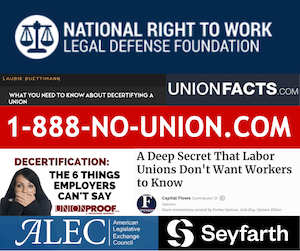Decertification is a process through which members of a union recognized by the National Labor Relations Board (NLRB) vote to dissolve that labor organization. Unless organizers try to elect a new bargaining unit, once a union is voted out, legal protections guaranteeing the right to negotiate a contract and any safeguards the union previously won from management go out the door with it.
Anyone who’s vaguely interested in the steps it takes to decertify a union has probably noticed after a quick search on the topic that there are a lot of people out there who are more than happy to show you the way. It’s a hyperventilating frenzy of union-busting think-pieces and guides written for bosses trying to wish away the rights of workers.

There’s a lot to learn from articles like these about how management may respond to any decertification campaign in the private sector. Please keep in mind though that your boss is not legally allowed to influence the outcome of or involve themselves at any point during a decertification effort.
So, if a coworker plans to decertify your union, you should know foul play to watch out for, how the process goes, when such a move is possible, and how to prevent the situation from happening in the first place.
“Management has no divine rights.”
- Walter Reuther, United Autoworkers Union
Know your rights: your boss cannot trigger decertification
Years of NLRB case precedent deems certain management behaviors in violation of workers rights during decertification campaigns. Here’s a few examples of what bosses cannot do. They:
- cannot offer to help employees initiate the decertification process.
- cannot use intimidation or fear of reprisal to encourage employees to pursue decertification.
- cannot initiate, instigate, solicit or encourage decertification because it interferes with an employee’s free choice.
- cannot provide resources in support of the decertification process.
- cannot tell employees who they should not talk to, instruct anyone to support decertification, or be involved in the petition process.
While determinations of what it means to interfere are up to the whims of a National Labor Relations Board (NLRB) whose members and ideologies are in flux as presidential administrations in Washington come and go, knowing how the Board has stood in the past can help you catch when your boss oversteps.
The process
Just as is the case when forming a private-sector union in the United States, decertification is a process overseen by the NLRB. 30 percent of workers in any given union must sign cards or a petition asking the NLRB to host a decertification election. Only after an election, in which over 50 percent of workers vote to dissolve their union, can the NLRB decertify one.
There are important limitations on the timing of such a campaign to keep in mind. The only “window period” when a worker can ask for a decertification election during the first three years of a bargaining agreement is a 30-day timeframe that runs from 90 to 60 days before such an agreement expires (120 to 90 days for workers in the healthcare industry). Workers are eligible to ask for an election at any other time once a collective bargaining agreement passes the three-year mark or expires.
Open dialogue and communication is key
The stronger a labor organization you have, the more it will reflect the values and needs of the workers it represents and the less likely you are to run into a decertification election. Disagreements are bound to arise, but like in any organization, providing a space for members to be heard, and keeping an open dialogue and transparency between members and bargaining representatives will lessen the likelihood of discontent.
Remind members that the dues they pay go directly toward organizing efforts to better the quality of life for them and their coworkers. If a union gets decertified, over time, they would likely make less than if they had stayed unionized, including the amount they spent on union dues. Workers would lose their legal right to a collective voice when discussing conditions on the job with management. Any of the rights earned through previous contract negotiations would no longer be a given.
Be sure to read our articles “Union democracy: who controls my union” and “What is a bargaining unit?” for more on union structure and organizational strategies.
Also, check out “The union difference: advantages of having a labor union” for the tangible, real-world benefits of having organized labor at your side.



